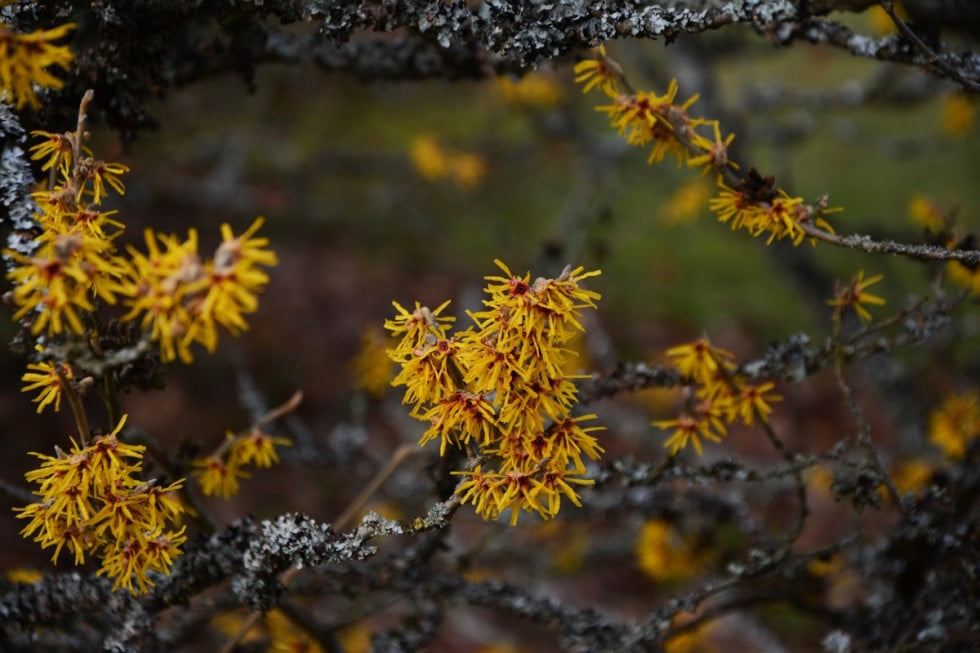Fantastic range of Witch Hazels in-stock
Witch hazel (Hamamelis) is a unique and enchanting shrub that graces gardens with its vibrant blooms and fascinating fragrance. We have, at The Nursery, a vast selection of 12 varities of witch hazels in stock right now. Its a really good time to choose your plant as the majority are in bloom so you can see exactly what you are getting. A full list of varieties is at the bottom of this article. These hardy plants thrive in various climates, making them a popular choice for garden enthusiasts. Here’s a guide on how to grow and care for witch hazel in the UK.
Choosing the Right Variety
Select a witch hazel variety suitable for the UK climate. At The Nursery we stock many species include Hamamelis mollis (Chinese witch hazel), Hamamelis japonica (Japanese witch hazel), and Hamamelis x intermedia hybrids (a cross between Chinese and Japanese witch hazel). For a terrific explanation of Witch Hazel we recomend taking a look at Carol Klein’s piece on Gardeners World Winter Special (View Gardeners World on iPlayer)
Planting Location
Witch hazel prefers well-draining soil and partial shade, although they can tolerate full sun. Choose a location that provides shelter from strong winds.
Planting Time
The best time to plant witch hazel is in autumn or early spring. This allows the plant to establish its roots before facing extreme weather conditions.
Soil Preparation
Improve the soil with organic matter like compost to help with drainage and fertility. Witch hazel is adaptable but thrives in slightly acidic to neutral soil.
Watering
Ensure consistent moisture, especially during dry spells. However, witch hazel doesn’t tolerate waterlogged conditions, so avoid overwatering.
Pruning
Prune witch hazel in late winter or early spring to shape the plant and remove any dead or damaged branches. This encourages healthy growth and enhances the overall appearance.
Mulching
Apply a layer of mulch around the base of the plant to retain moisture and suppress weeds. This is particularly beneficial during the drier months.
Fertilizing
Witch hazel generally doesn’t require much fertilization. If needed, use a balanced fertilizer in early spring before new growth begins.
Protecting from Pests and Diseases
Witch hazel is relatively resistant to pests and diseases. However, occasional checks for aphids or spider mites are recommended. Treat any issues promptly.
Enjoying the Blooms
One of the most delightful aspects of witch hazel is its unique winter and early spring blooms. Be patient, as it might take a few years for the plant to reach its full flowering potential.
Appreciating Autumn Colors
In addition to its captivating blooms, witch hazel exhibits stunning autumn foliage. The leaves turn various shades of yellow, orange, and red, adding seasonal interest to your garden.
Winter Considerations
Witch hazel is hardy, but in severe winters, consider protecting the plant with a layer of mulch around the base to shield the roots from frost.
By following these guidelines, you can cultivate a thriving witch hazel in your UK garden, bringing a touch of magic to your outdoor space with its charming flowers and vibrant foliage.
Witch Hazel in-stock
at The Nursery
HAMAMELIS mol. ‘JERMYN’S GOLD’
Highly fragrant yellow flowers with strong and thick petais. Flowers Dec and Jan. Good Autumn colour. Height after 10 years 2m
HAMAMELIS x int. ‘HILTINGBURY’
Pale copper, suffused red flowers. Flowers Dec to March, Vibrant shades of orange & scarlet autumn foliage. Height after 10 years 2m
HAMAMELIS x int. ‘PALLIDA’
Sweetly scented sulphur-yellow. Flowers in Winter. Slow-growing medium-sized shrub. Good autumn foliage colour. Height after 10 years 1m
HAMAMELIS x int. ‘ARNOLD PROMISE’
Sweetly scented pale yellow flowers. Flowers Jan to March. Outstanding red/orange autumn foliage colour. Height after 10 years 1.5m
HAMAMELIS x int. ‘ATHENA’
Intense copper-red flowers. Flowers mid to late winter. Slightly fragrant. Height after 10 years 2-2.5m
HAMAMELIS x int. ‘CARMINE RED’
Lightly sweet-scented copper/ bronze flowers. Flowers from Jan to early March. Yellow autumn foliage colour. Height after 10years 2m
HAMAMELIS x int. ‘ANGELLY’
Slightly scented lemon-yellow flowers are produced in late February. Slower growing than other varieties, so ideal for a small garden.
HAMAMELIS x int. ‘LUNA’
Small smoky yellow flowers, orange at base of petal. Flowers Jan to March. Good autumn foliage colour. Height after ten years 2m
HAMAMELIS jap. ‘BRENTRY’
Light yellow flowers in dense clusters. Floers early February. Green hazel-like leaves. Good Autumn colour. Height after 10 years 1.5m
HAMAMELIS x int. ‘SWALLOW HAYES’
Sulphur-yellow flowers. Oval, wrinkled, mid-green leaves, yellow-green when young in spring, turning yellow in autumn. Lightly fragrant. Height after 10 years 1.5m.
HAMAMELIS x int. ‘VESNA’
Large yellow flowers that are orange-red at the base are produced during the winter. Excellent autumn colour, bright rainbow like striped leaves. Height after 10 years 2m
AMAMELIS x int. ‘WESTERSTEDE’
Strongly fragrant yellow flowers. Flowers Jan to March. Good autumn foliage colour. Height after 10 yrs 1.5m
HAMAMELIS x int. ‘BARMSTEDT GOLD’
Deep golden-yellow flowers, slightly fruity fragrance. Flowers Feb. Green leaves. Height after 10 yrs 1.5m
For advice on Witch Hazels or any other garden or plant enquiries, please feel free to ask. We are always delighted to help on a face-to-face basis at The Nursery. So do pop in, have a look at our beautiful plant stock and say hello. Look forward to seeing you
Matt
The Nursery Garden Centre near Trowbridge is owned and operated by Matthew Webb, a professional horticulturist . Matthew built it from scratch and loves his job, his staff and his customers. Plants are his passion and he adores growing, nurturing and knowing as much as possible about them and then passing on his expert knowledge to staff and customers.



